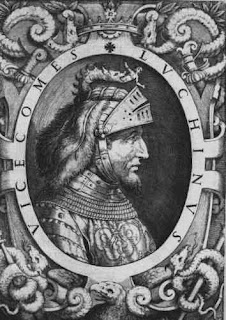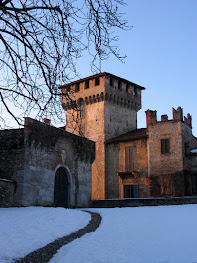When Visconti fought Visconti for control of Milan
 |
| One of the bronze doors of Milan cathedral, sculpted by Giannino Castiglioni, includes a scene from the battle |
The Battle of Parabiago in 1339 saw the armies of Azzone Visconti, the ruler of Milan, defeat an attempt to unseat him by his exiled uncle, Lodrisio Visconti, leader of a mercenary army named the Compagnia di San Giorgio - the Company of St George.
In 1311, Lodrisio had helped Matteo Visconti and his son Galeazzo regain the rulership of Milan from the Della Torre family, who had previously held power in the city but was later instrumental in imprisoning Galeazzo and his son, Azzone, as part of a power struggle. When Galeazzo and Azzone ultimately escaped, Lodrisio fled.
Initially holding up in his castle at Seprio, about 38km (24 miles) northwest of Milan, near the city of Varese, he was besieged by soldiers led by Azzone, who destroyed the castle but failed to capture Lodrisio.
In exile, Lodrisio became a condottiero - a mercenary military leader - and found employment with the Della Scala family of Verona, also known as the Scaligeri, who controlled much of the area that today makes up Veneto, with the exception of Venice, as well as the key strategic cities and surrounding territories of Brescia in Lombardy, Parma in Emilia-Romagna and Lucca in northern Tuscany.
 |
| Azzone Visconti, Lord of Milan, who died soon after his army's victory |
With the help of the Scaligeri, Lodrisio assembled an army of 6,500 men, made up of 2,500 mainly German knights, 1,000 Swiss halberdiers, and infantry and militia supplied by the Scaligeri. In 1339, the army was named the Compagnia di San Giorgio. Its first contract was to capture Milan for the Della Scala family, who had a score to settle with Azzone Visconti after he supported Venice in an earlier conflict against Verona.
Azzone, who was in poor health, ruled Milan with the help of two uncles, Luchino Visconti and Giovanni Visconti, the Bishop of Milan.
Lodrisio’s army set out for Lombardy in late January, 1339. They met resistance from the Milanese in Rivolta d'Adda, Cernusco sul Naviglio, Sesto di Monza and Legnano but each time had the numbers and the expertise to prevail.
In the meantime, with Azzone confined to Milan because of gout, Luchino had assembled a force comprising his citizen militia and 700 knights from Savoy, led by the Bolognese commander Ettore da Panigo.
Luchino's army into two corps, one of which established a camp just outside the village of Parabiago. It was here, on 20 February, in deep snow, that Lodrisio launched an attack. Fierce fighting entailed, with heavy casualties on both sides, but ultimately Lodrisio’s company claimed victory, capturing Luchino.
There were more casualties as the Milanese force retreated but amid the confusion of the battlefield, not helped by the weather conditions, remaining elements of Luchino’s militia offered more resistance, delaying Lodrisio’s progress towards the city. This bought enough time for Azzone to organise reinforcements.
 |
| Luchino Visconti was captured and then freed - perhaps by the saint |
Da Panigo and Luchino were now able to join Azzone’s reinforcements in launching a violent assault on Lodriso’s remaining German knights and what followed was a rout.
Legend has it that an apparition of Sant’Ambrogio (Saint Ambrosius), the patron saint of Milan, descended on horseback from a cloud to lead the Milanese troops in the decisive moments of the battle, and caused their enemies to panic. A variation on the same story is that Sant’Ambrogio had intervened to untie the ropes binding Luchino to a walnut tree.
Although the victory belonged to Azzone and Luchino, there was a heavy price in bloodshed. It is estimated that 2,300 Milanese soldiers were killed, and at least 4,500 members of the Compagnia di San Giorgio.
Lodrisio was taken prisoner and locked up in an iron cage at the Castle of San Colombano al Lambro, southeast of Milan between Pavia and Piacenza. Although Azzone died soon after the battle, Lodrisio was not released until after Luchino’s death in 1349, when Archbishop Giovanni, who succeeded Luchino as Lord of Milan, granted him his freedom.
To give thanks for the successful defence of Milan, Giovanni Visconti had a church and an abbey built on the site of the battle in Parabiago, called Sant'Ambrogio della Vittoria - St. Ambrose of the Victory. Until 1581, a procession from Milan to Parabiago took place in February each year to remember the victory.
 |
| The campanile of the church of Sant'Ambrogio |
The Parabiago of today falls within the boundaries of the greater Milan metropolitan area. After the battle it remained a relatively obscure village but began to grow in the 18th century and expanded quickly with the Industrial Revolution, becoming a centre for textile manufacture and shoe-making. After the first shoe factory was opened in 1899 and others followed, it became known as La Città della Calzatura - the City of the Shoe. It enjoyed a further boom in the 1960s and now has a population of almost 28,000. The original Chiesa di Sant’Ambrogio della Vittoria was demolished and another built in its place in the 18th century.
 |
| A snowy scene at the Castello Visconti di San Vito |
The castle to which Lodrisio Visconti originally fled following his exit from Milan may have been what is now the Castello Visconti di San Vito at Somma Lombardo, a town about 22km (14 miles) southwest of Varese that in mediaeval times came under the jurisdiction of the nearby town of Arsago Seprio, then an important political centre. The castle’s origins are said to date back to the ninth century. Development of the castle into a palace was started in 1448 by the brothers Francesco and Guido Visconti. In the 1950s, the castle complex came under the ownership of the Marquis Don Alberto Visconti of San Vito, a descendent of Francesco Visconti. Nowadays, it hosts meetings, seminars and banquets and is a popular venue for weddings.
Also on this day:
1549: The birth of Francesco Maria II della Rovere - the last Duke of Urbino
1778: The death of ground-breaking physicist Laura Bassi
1816: Rossini’s opera The Barber of Seville premieres in Rome
1993: The death of car maker Ferruccio Lamborghini



























